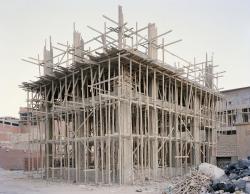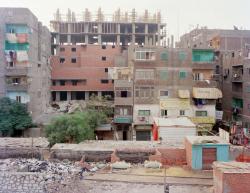ARTIST TALK
Saturday, July 27 @ 1:30 pm
Saturdays
Noon - 4 pm
In an ongoing partnership with The Center for Emerging Visual Artists (CFEVA) we are pleased to present Future Cities, Cairo, an Alumni Solo Exhibition featuring work by Noah Addis curated by Stella Gassaway. The exhibition is on view through July 27, 2013 at 110 CHURCH gallery located at 110 Church Street in Old City Philadelphia.
The First Friday opening reception will be on Friday, June 7 from 5 – 9pm and there will be an artist talk in July. Gallery hours for this exhibition are Wednesdays, Thursdays, and Fridays from 1:30 – 6:30pm, and by appointment.
Future Cities is an ongoing photo-based project by Noah Addis to explore informal settlements and unplanned growth in the world’s major cities. Squatter communities take on many forms, from the dense conglomeration of multi-story reinforced concrete structures of Cairo as displayed in this exhibition, to the sprawling shantytowns or simple huts in other cities across the world that the artist has visited and documented.
Traditional social theory believed that urbanization would follow industrialization. However many of the worlds megacities, particularly those in the developing world, are undergoing massive population growth at the same time they are experiencing a loss of industrial jobs and stagnant economies. Meanwhile, due to mechanized farming, industrial-scale agribusiness, civil war, draught, climate change and countless other factors, the hardships of rural life drive many to look for opportunity in the world’s urban centers.
All the cities Addis investigates through the Future Cities project share a common history: people, mostly migrants from rural areas, came to the city in search of work. They were in need of affordable housing that could not be found on the open market. So they claimed a small piece of unused land and built a home. Other residents followed suit, and the result was a new community within the city.
In 1950 there were 86 cities in the world with a population greater than one million. Today there are 400, and by 2015 there will be more than 550. Lagos, Nigeria, for example, has grown from a population of 300,000 in 1950 to 14 million today. Much of this growth is happening in squatter communities. Sao Paulo’s favelas contained 1.2 percent of its total population in 1973 and that number grew to 20 percent in 1993. Of the half-million people who migrate to Delhi each year, an estimated 400,000 live in the city’s slums. In Nigeria, nearly 80 percent of the urban population, more than 40 million people, live in squatter communities.



